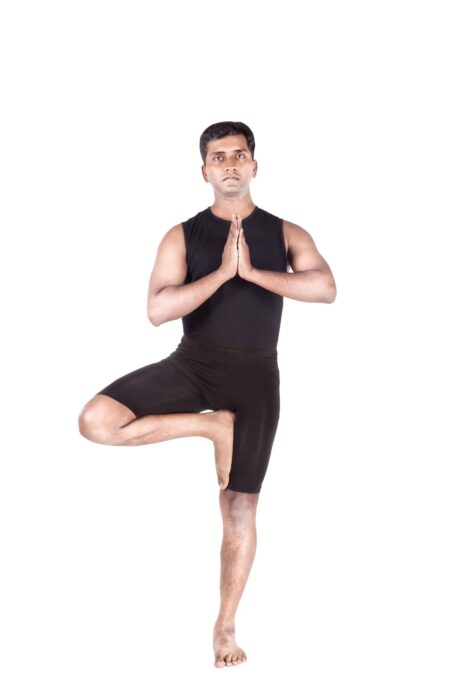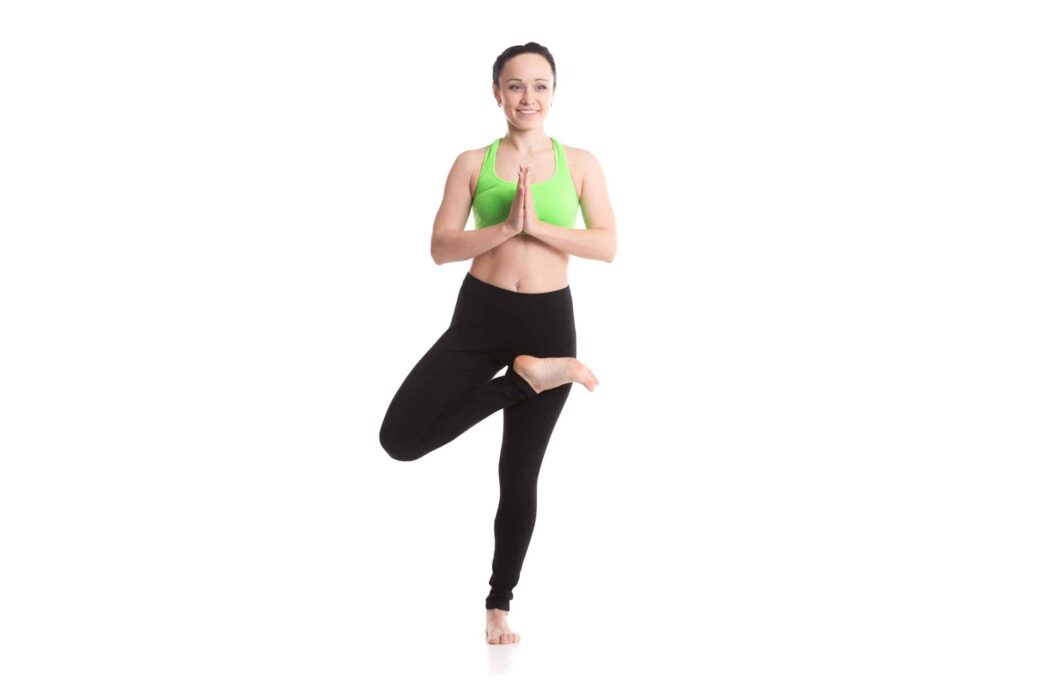
वृक्षासन
Vrikshasana /VRIK-shAH-sana/ = Vriksha: Tree
Goals: to build legs strength and balancing skills
You can’t strengthen the body’s upper parts in yoga without maintaining balance and a stable connection with the ground. Simply speaking, if you can’t stand on one leg smiling, there is no point in training for inversions. So, the first thing you need to learn as a beginner is a Tree pose.
Half-Moon Pose (Ardha Chandrasana)
How to Get Into It
- Start in Tadasana. Palms pressed together in front of your chest in Anjali Mudra (prayer’s gesture). Circle your shoulders back and soften them. Lengthen your neck and relax your facial muscles.
- Move your attention to the soles and take a moment to root them on the ground. Start shifting your body weight to one leg (no matter which one left or right, let’s say you’ve picked the right one).
- Bring another leg up, bend the knee and press the sole of it to the inner side of the calf (more accessible), inner thigh (challenging).
- Tuck your tailbone and ensure your pelvic bones are in line with each other. If you notice that one side of your pelvic goes up (usually, it happens if you have tight hips or deep pelvic muscles need more stretching), try to align the pelvis. Keep your back straight.
- Keep palms either in front of the chest or bring your arms up over the head, palms but facing each other.
- Hold the position for 5-10 breath cycles and then repeat on another leg.
Benefits
- The asana allows building balance through your soles, ankles.
- It helps open hips and stretch pelvic muscles, and align your knees and hips joints properly.
- It creates an easy attitude to life, as you try to maintain balance and try not to fall off your shaking leg.
Precautions
I would not recommend it if you have a fresh hip or knee surgery or trauma.
Common Mistakes
This pose is all about the alignment of your joints. If your toes point in one direction and your knee in another – there is no point in trying to maintain the balance. So the first thing to do here is to align your joints starting from heels.
So, ensure your toes and knee caps are aligned in one direction and are facing the front line of your mat. Same with your hips. Feet are parallel to each other.
Back Position
Ensure your lower back is in a neutral position. Avoid arching that can cause pain in the lower back in the future. For this, your tailbone is tucked, tone your abs a little bit, and engage your core to hold the proper posture in the Tree pose.
“Scared” Face
Relax the muscles that are not participating in this asana, e.g., face muscles and shoulders. Draw your shoulders blades away from your ears and relax them. Check your face and soften it if you find some tension there. Yoga is also about picking what muscles are working and what are resting as you practice.
Modifications
Beginner: Use a wall or chair for support if you feel it isn’t easy to balance.
Pro: Close your eye in the pose and see how the sensation changes here. Also, you can put the bent leg in the Half-lotus position to work more on opening hips (check the picture below):
